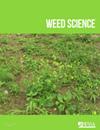温度和热量单位对结缕草休眠后对除草剂反应的影响
IF 2.1
2区 农林科学
Q2 AGRONOMY
引用次数: 1
摘要
摘要在过渡区,草坪草管理者通常利用暖季草坪草的休眠期施用除草剂来管理冬季一年生杂草。尽管这种杂草控制策略在狗牙根[犬齿草(L.)Pers.]中很常见,但由于休眠后过渡期间草坪草的损伤程度不同,它在结缕草(Zoysia spp.)中的应用较少。先前的研究报告称,气温可能会影响除草剂对杂草的控制和作物安全。进行了生长室研究,以评估结缕草在处理期间和处理后受三种不同温度制度影响对草甘膦和草膦的反应。在四个地点年进行了一项实地研究,以评估可变热量单位积累对结缕草对七种除草剂反应的影响。在生长室研究中,当在不同温度水平下孵育7天时,草膦对结缕草的伤害大于草甘膦,并缩短了达到50%绿色覆盖减少的时间,无论速度如何。当绿色结缕草枝条在10℃下培养7天时,两种除草剂的绿色覆盖减少速度都减慢;然而,在27℃下,绿色覆盖物迅速减少。在具有5%绿色覆盖物的处理过的结缕草插塞在10℃下孵育14天后,草甘膦处理过的插塞在22天内达到50%绿色覆盖物,类似于未处理的插塞,但小于草膦处理过的插头所需的70天。结缕草对草甘膦的反应是温度依赖性的,但无论温度如何,草膦对结缕草的伤害都是不可接受的。在基础5 C(GDD5C)施用时间下,百草枯、氟嘧嗪、草膦和甲磺隆+林磺隆在200或300生长度日对结缕草有损伤,但无论GDD5C如何,甲磺隆和恶二唑均不损伤结缕草。叶密度与草坪覆盖率的关系取决于结缕草的割草高度,并且这两个指标都会被有害除草剂降低。研究表明,草磷对结缕草的伤害大于草甘膦,除草剂的伤害速度和程度通常随温度的升高而增加。本文章由计算机程序翻译,如有差异,请以英文原文为准。
Effect of Temperature and Heat Units on Zoysiagrass Response to Herbicides During Post-Dormancy Transition
Abstract In the transition zone, turfgrass managers generally utilize the dormancy period of warm-season turfgrass to apply herbicides for managing winter annual weeds. Although this weed control strategy is common in bermudagrass [Cynodon dactylon (L.) Pers.], it has been less adopted in zoysiagrass (Zoysia spp.) due to variable turfgrass injury during post-dormancy transition. Previous research reported that air temperature could affect weed control and crop safety from herbicides. Growth-chamber studies were conducted to evaluate zoysiagrass response to glyphosate and glufosinate as influenced by three different temperature regimes during and after treatment. A field research study was conducted at four site-years to assess the influence of variable heat-unit accumulation on zoysiagrass response to seven herbicides. In the growth-chamber study, glufosinate injured zoysiagrass more than glyphosate and reduced time to reach 50% green cover reduction, regardless of the rate, when incubated for 7 d under different temperature levels. When green zoysiagrass sprigs were incubated for 7 d at 10 C, the rate of green cover reduction was slowed for both herbicides; however, green cover was rapidly reduced under 27 C. After treated zoysiagrass plugs having 5% green cover were incubated at 10 C for 14 d, glyphosate-treated plugs reached 50% green cover in 22 d, similar to nontreated plugs but less than the 70 d required for glufosinate-treated plugs. Zoysiagrass response to glyphosate was temperature dependent, but glufosinate injured zoysiagrass unacceptably regardless of temperature regime. Diquat, flumioxazin, glufosinate, and metsulfuron + rimsulfuron injured zoysiagrass at 200 or 300 growing-degree days at base 5 C (GDD5C) application timings, but foramsulfuron and oxadiazon did not injure zoysiagrass regardless of GDD5C. The relationship of leaf density to green turf cover is dependent on zoysiagrass mowing height, and both metrics are reduced by injurious herbicides. Research indicates that glufosinate injures zoysiagrass more than glyphosate, and the speed and magnitude of herbicide injury generally increase with temperature.
求助全文
通过发布文献求助,成功后即可免费获取论文全文。
去求助
来源期刊

Weed Science
农林科学-农艺学
CiteScore
4.60
自引率
12.00%
发文量
64
审稿时长
12-24 weeks
期刊介绍:
Weed Science publishes original research and scholarship in the form of peer-reviewed articles focused on fundamental research directly related to all aspects of weed science in agricultural systems. Topics for Weed Science include:
- the biology and ecology of weeds in agricultural, forestry, aquatic, turf, recreational, rights-of-way and other settings, genetics of weeds
- herbicide resistance, chemistry, biochemistry, physiology and molecular action of herbicides and plant growth regulators used to manage undesirable vegetation
- ecology of cropping and other agricultural systems as they relate to weed management
- biological and ecological aspects of weed control tools including biological agents, and herbicide resistant crops
- effect of weed management on soil, air and water.
 求助内容:
求助内容: 应助结果提醒方式:
应助结果提醒方式:


